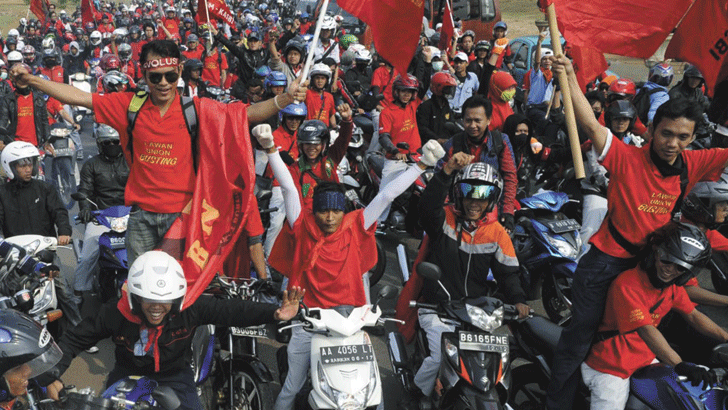Indonesian unions divided on next steps

During July and August, the Indonesian government firmed up its resistance to any further large increases in the minimum wage. Regulations are to ensure that wage increases don’t exceed companies’ “capacity to pay”.
The regulatory offensive is meant to consolidate a several months long counteroffensive against the newly emerging trade union movement that employers and government launched after a million-strong national workers’ mobilisation on 3 October 2012. The counteroffensive has used legal channels, gangs of thugs, mass sackings and divide and rule tactics, and has been assisted by attitudes of accommodation by a new bureaucracy among the union leaderships.
The counteroffensive has been successful in damping worker activity; strikes and other protests have been in decline since around November. In recent talks with the minister of industry and the head of the Indonesian Entrepreneurs Association (APINDO), the heads of two major union federations more or less offered support for the government’s insistence that unions exercise wage restraint.
However, this was rejected by another leader, Said Iqbal, from the Indonesian Metal Workers Federation (FSPMI), who is also head of the major union alliance Indonesian Workers Assembly (MPBI), which organised the 3 October mobilisation. The other union leaders were also members of MPBI, indicating that new differences might be emerging among the union leaders.
Breakout
When the dictator General Suharto was pushed from power in 1998, the new president, B.J. Habibie, quickly ratified International Labour Organization conventions on trade union rights, and the state ended its policy of tight control over the single “union” organisation that was allowed.
During the next 10 years, that organisation fractured and fragmented as rival leadership cliques struggled over control, while at the same time there were also independent initiatives from the factory floor to win leadership or even start new unions. Thousands of new enterprise unions were registered.
After more than a decade of this internal tumult and enterprise union expansion, Indonesia now has several major union federations independent of the state.
During 2010-12 worker protest actions expanded rapidly, demanding wage rises and also an end to casual labour hire practices (outsourcing). Around 80 percent of factory workers, including in the central production line processes, were being employed on labour hire contracts, with low wages and no rights. This was a violation of Indonesian law.
Wages had dropped below the official government estimate of what was needed for minimum physical survival. These protests took on a more combative form, with militant workers moving through factory areas and calling out workers from other factories.
There were pickets, as well as road blockades and city protests. Hundreds of thousands of workers were involved around the country. The militancy climaxed in the 3 October national protests, mobilising around 1 million workers – although only a minority were actually on strike. The campaign won rises in the minimum wage of between 40 percent and 120 percent, depending on the region.
Bosses’ counterattack
There was an immediate counterattack. Anti-worker leaflets threatening strikers in the name of various new organisations appeared among communities in the poor factory worker areas. Soon after, gangs of thugs appeared, sometimes up to 400 men, recruited from the poorest areas.
They attacked and harassed picket lines and burned down worker offices. Many companies started to deploy these thugs, as well as soldiers, on site. The thugs would follow outspoken workers home and threaten them and their families.
Meanwhile, when companies had been forced to end labour hire, they would upgrade workers to contracts, but often give different groups better or worse conditions, dividing the union membership. Some workers have been charged with criminal libel against employers and may end up in court or jail.
In other cases, workers were made redundant and offered pay-offs, resulting in drops in memberships of some unions. Many employers have successfully applied to government bodies for a postponement of wage rises. Despite inspiring incidents of workers fighting off large brigades of thugs back in November, there has been a demoralising impact on sections of the union membership.
This has been made worse by union bureaucrat conservatism. Almost immediately after the counterattack started, there were retreats. On 8 November, union leaders, including from the FSPMI, signed a “Declaration of Harmony” with APINDO and government officials.
In the aftermath of this agreement, union leaderships discouraged worker protests, including the popular solidarity actions between factories. Workers were instructed to withdraw from several union-community alliances in several cities.
Two worker centres that had been dynamic recruiters and educators for new members, often channelling 1,000-2,000 workers a day into unions, came under suspicion. Their voluntary worker trainers were replaced by new people who often had not been active.
Teachers of economics and politics courses, even English, have been removed. Worker resistance to the thug presence has been channelled into ineffective symbolic national actions at the expense of preparations to deal with the thugs inside factories.
As some workers become demoralised, others become increasingly angry. Polarisation among members is likely into the next period. Meanwhile, Said Iqbal’s insistence that workers should campaign for another 50 percent wage increase while other leaders acquiesce in the government’s line of no more increases appears to point to internal struggle developing among the leaderships.
A reorganisation of the mainstream unions may be in the making. If it does happen, it will provide an opportunity for the small unions attached to socialist propaganda groups to reassess their policy of organising separately from the 3 million workers organised in the big unions.